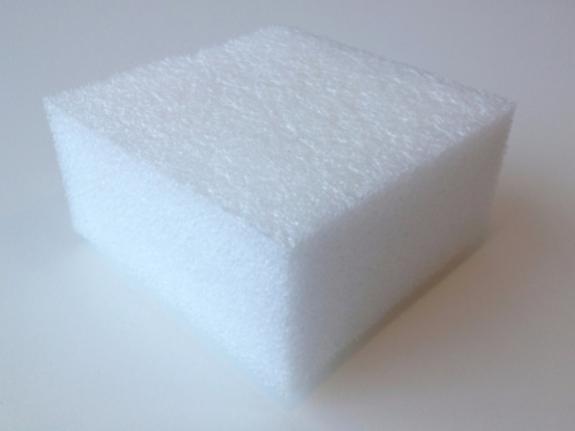Ethafoam
Description
[Sealed Air Corporation, formerly Dow Chemical Company] A registered trademark for a polyethylene foam plank. Ethafoam® is a durable, flexible, closed-cell foam that is waterproof and chemical resistant with an excellent memory. It performs consistently through a wide range of temperatures. It is easily cut with knives, hot knives, band saws, powered foam rubber cutters, and table saws. Ethafoam® adheres to itself and other polyethylene-based materials with heat-welding, or to most other surfaces with industrial-grade hot glue. The natural color of polyethylene foam is brilliant, sparkling white with a slight translucence in thin areas, but black and blue are also available in a limited range of sizes.
Synonyms and Related Terms
Related products: PolyPlank EXT220; PolyPlank LAM220; Microfoam; Senitel; Cell-Aire
Applications
- Shock-absorbing and vibration-dampening for transport
- Temperature and moisture resistant
- Mount-making using the rigidity of 900
Personal Risks
Ethafoam® is manufactured with blowing agents that can be released from broken cells into the atmosphere when it is cut or melted. These blowing agents are toxic and technically flammable, but they will not combust by accidentally melting the foam with the tip of a hot glue gun, or by heat-welding to another piece of foam. A well ventilated workspace is recommended when fabricating to mitigate the minor toxicity.
Ethafoam® SDS [[1]]
Environmental Risks
May be recycled.
Working Properties
Ethafoam® polyethylene was developed specifically for shock-absorption, vibration suppression, insulation & buoyancy in storing and transporting military, computer, and medical equipment, and other precision instruments (PACCIN). Sheets and planks have a skin on each of the large faces. The skin is an unbroken surface, but has a bubbly texture with approximately 1mm relief, and despite the absence of additives the foam feels waxy to the touch. The edges of the planks expose open cells where they have been broken. Individual cells range between 1-2mm diameter at medium density. Plank edges and other cut surfaces create a rougher texture than that of the closed skin. Both surfaces are generally considered too abrasive for making direct contact with sensitive surfaces, and require the mediation of a smoother material between the Ethafoam® and the object, such as Tyvek Softwrap, Volara, or poly-sheeting for a few examples. This mediation can be achieved either by lining the foam or wrapping the object.
It is more firm than open-cell foams of equivalent pcf densities, such as polyurethanes. In fact, 220 is not soft enough to be highly recommended for cavity packing lightweight objects or, as noted above, full-contact cushioning over broad surfaces. However, it carves well with sharp knives for precise contouring of cushioning pads. 220 is stiff enough to employ as yokes for large rolling tubes or guillotines for moderately sized sculptures. Heavier objects can be secured with pads & wood bracing, and with the further option of greater foam densities. 900 is typically reserved for support underneath objects weighing several hundred lbs or more or in storage and mountmaking applications where it's rigidity makes it work almost like wood.
Forms/Sizes
The 2" material has a useful balance of dimensionality, stiffness, and ease of cutting. Strips or blocks cut from it can be quickly laminated into much thicker cushions as needed.
- Ethafoam 220 = 2.2 pcf in 2" natural tint (white) sheets (most common)
- Ethafoam 400 = 4.0 pcf.
- Ethafoam 700 = 7.0 pcf. (Formally 6.0 pcf from Dow, known as Ethafoam 600).
- Ethafoam 900 = 9.0 pcf.
Sheets and planks are not quite flat on the faces, tapering slightly at the two long edges. The long edges also tend to have concave surfaces and a manufacturer's stamp, so it is recommended to trim strips at least 1" wide off any factory edges and discard. The actual thickness of a single 2" plank can range between 2” – 2.25” approximately. For the purposes of cushioning crates with moderately tight tolerances of fit, Ethafoam is often ordered from regional vendors with the skin skived off one side to produce a flatter face and a more consistent 2” thickness. It can also be skived into 1” thick planks, also with a skin on one side only. Small variations in thickness should still be expected in skived foam.
Other Variations
- Ethafoam AS is an anti-static formulation of polyethylene foam that meets EIA 541 requirements for static decay and surface resistance. Bright pink in color, it shares all of standard Ethafoam's shock absorption and insulation qualities.
- Ethafoam M is formulated with less than 10% LEL (low explosive limit) VOC, which meets military and other low residual blowing agent specifications.
- Ethafoam Synergy is formulated with smaller cells for a smoother texture; fine and ultra-fine.
- Ethafoam FS - with fire-suppressant additives for use in the airline industry - has not been included here.
For a complete list of selections please see Preparation, Art Handling, Collections Care Information Network (PACCIN)
Resources and Citations
- Sealed Air Corporation: [Ethafoam]
- Rachael Perkins Arenstein, Lisa Goldberg, and Eugenie Milroy, ‘Support and Rehousing for Collection Storage’ In ‘Preventive Conservation: Collection Storage’ Lisa Elkin and Christopher A. Norris (eds.), Society for the Preservation of Natural History Collections, New York. 2019.
- National Park System, Conserv O Gram, Number 8/2, 'Safe Plastic & Fabrics for Display & Storage': Link

